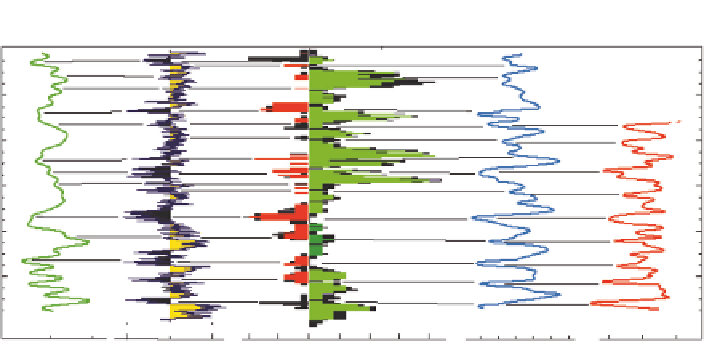Geoscience Reference
In-Depth Information
a
b
c
d
2
2
4
4
6
6
8
8
10
10
Low level
Low level
4
0
-4
0.4
0
-0.4
0.5
0
-0.5
20
0
-20
10
0
Mid-European
lake-level changes
10
20
Residual D
14
C
Ice rafting debris
in the North Atlantic
10
Be production
(atoms cm
-
2
s
-
1
)
PCI in GISP2
(normalized units)
Figure 2.4
Comparison of mid-European lake-level changes (c) with (a) the Polar
Circulation Index (PCI) at GISP2 (Mayewski
et al
. 1997); (b) the detrended deviation of
the atmospheric
14
C/
12
C ratio from a standard value as an indicator of solar activity;
(d) the amount of ice-rafted debris found in sediment cores as a measure of the
southwards drift of icebergs in the North Atlantic (after Bond
et al
. 2001) and (e) a solar
modulation function derived from
10
Be data from the GRIP ice core (Beer & van Geel
2008). (Modified from Beer & van Geel 2008 and Magny 2004.)
imprecision of lake sediment dating (cf. Petterson
et al
. 2010). Nevertheless, and
whatever the cause, there is abundant evidence to show that lake ecosystems have
varied and can vary significantly on these timescales. The record includes evidence
for repeated changes in moisture regimes affecting lake water level and cyclical
changes in temperature affecting lake productivity as well as century-long
excursions in climate, the mechanisms for which are not fully understood.
Effective moisture variability and changes in lake water level
Significant changes in lake water level over the Holocene in temperate regions
of Europe and North America have been described by both Digerfeldt (1988)
and Magny (1992, 2004). Digerfeldt's work in southern Sweden was based
principally on the analysis of macrofossils of aquatic macrophytes in sediment
cores taken along transects from lake margins into deep water. He used
stratigraphic differences in the macrofossil record between cores along the
transect to reconstruct changes in the position of marginal reedswamps that
could then be related to lake-level change and, by extension, to climate change.
Magny, on the other hand, worked on hard-water lakes in the Jura Mountains,
the French pre-Alps and the Swiss Plateau. He employed essentially the same
approach as Digerfeldt but used carbonate nodules instead of aquatic macrofossils
as indicators of water-level change. He demonstrated (Fig. 2.4, Magny 2004)
that the reconstructed water-level changes were largely in phase with other
palaeo-records of climate change, including the proxy climate record from a




























Search WWH ::

Custom Search